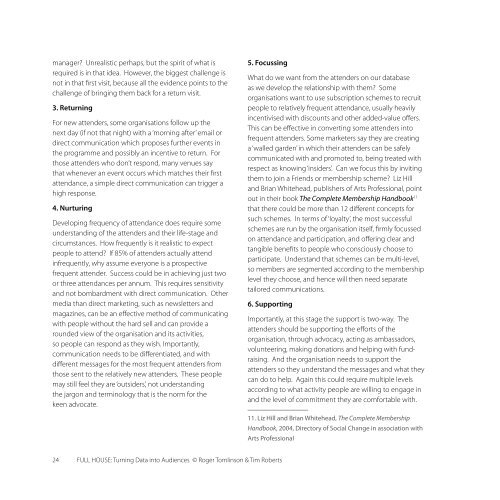FULL HOUSE Turning Data into Audiences - ARTS Australia
FULL HOUSE Turning Data into Audiences - ARTS Australia
FULL HOUSE Turning Data into Audiences - ARTS Australia
You also want an ePaper? Increase the reach of your titles
YUMPU automatically turns print PDFs into web optimized ePapers that Google loves.
manager? Unrealistic perhaps, but the spirit of what isrequired is in that idea. However, the biggest challenge isnot in that first visit, because all the evidence points to thechallenge of bringing them back for a return visit.3. ReturningFor new attenders, some organisations follow up thenext day (if not that night) with a ‘morning after’ email ordirect communication which proposes further events inthe programme and possibly an incentive to return. Forthose attenders who don’t respond, many venues saythat whenever an event occurs which matches their firstattendance, a simple direct communication can trigger ahigh response.4. NurturingDeveloping frequency of attendance does require someunderstanding of the attenders and their life-stage andcircumstances. How frequently is it realistic to expectpeople to attend? If 85% of attenders actually attendinfrequently, why assume everyone is a prospectivefrequent attender. Success could be in achieving just twoor three attendances per annum. This requires sensitivityand not bombardment with direct communication. Othermedia than direct marketing, such as newsletters andmagazines, can be an effective method of communicatingwith people without the hard sell and can provide arounded view of the organisation and its activities,so people can respond as they wish. Importantly,communication needs to be differentiated, and withdifferent messages for the most frequent attenders fromthose sent to the relatively new attenders. These peoplemay still feel they are ‘outsiders’, not understandingthe jargon and terminology that is the norm for thekeen advocate.5. FocussingWhat do we want from the attenders on our databaseas we develop the relationship with them? Someorganisations want to use subscription schemes to recruitpeople to relatively frequent attendance, usually heavilyincentivised with discounts and other added-value offers.This can be effective in converting some attenders <strong>into</strong>frequent attenders. Some marketers say they are creatinga ‘walled garden’ in which their attenders can be safelycommunicated with and promoted to, being treated withrespect as knowing ‘insiders’. Can we focus this by invitingthem to join a Friends or membership scheme? Liz Hilland Brian Whitehead, publishers of Arts Professional, po<strong>into</strong>ut in their book The Complete Membership Handbook 11that there could be more than 12 different concepts forsuch schemes. In terms of ‘loyalty’, the most successfulschemes are run by the organisation itself, firmly focussedon attendance and participation, and offering clear andtangible benefits to people who consciously choose toparticipate. Understand that schemes can be multi-level,so members are segmented according to the membershiplevel they choose, and hence will then need separatetailored communications.6. SupportingImportantly, at this stage the support is two-way. Theattenders should be supporting the efforts of theorganisation, through advocacy, acting as ambassadors,volunteering, making donations and helping with fundraising.And the organisation needs to support theattenders so they understand the messages and what theycan do to help. Again this could require multiple levelsaccording to what activity people are willing to engage inand the level of commitment they are comfortable with.1. Liz Hill and Brian Whitehead, The Complete MembershipHandbook, 2004, Directory of Social Change in association withArts Professional24 <strong>FULL</strong> <strong>HOUSE</strong>: <strong>Turning</strong> <strong>Data</strong> <strong>into</strong> <strong>Audiences</strong> © Roger Tomlinson & Tim Roberts


